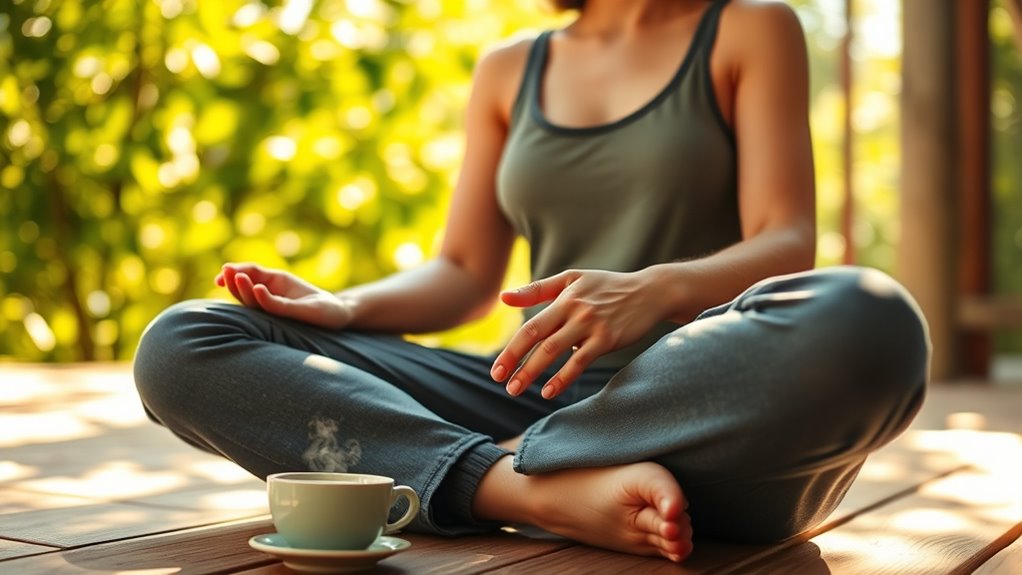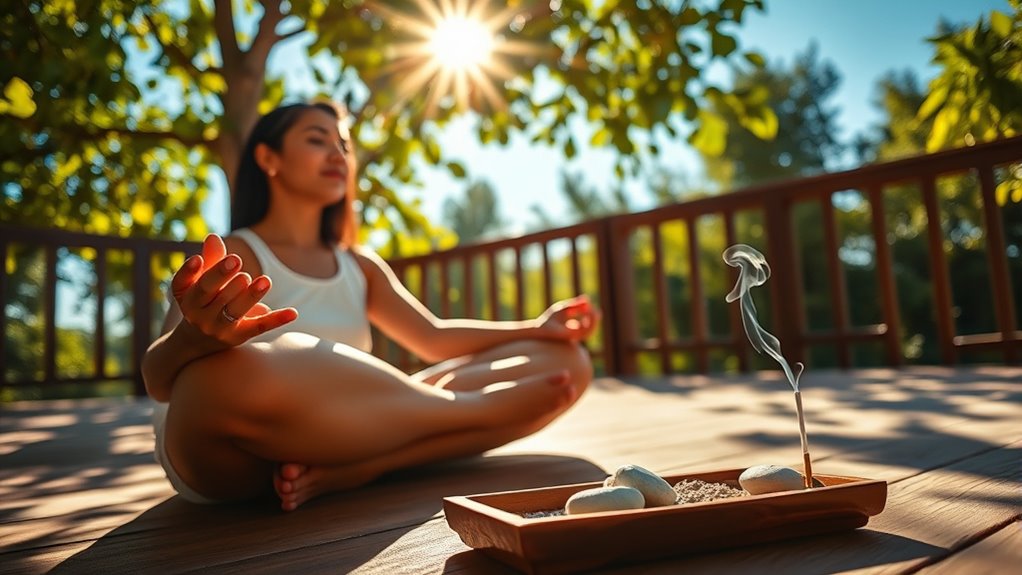In under a minute, you can practice quick mindfulness micro-practices to reduce stress and boost focus. Try inhaling slowly through your nose, feeling your lungs expand, then exhaling gently through your mouth or nose. Alternatively, do a quick body scan, paying attention to sensations from your toes upward, or simply pause to notice your breath or body tension. These easy exercises fit into your busy schedule and can help you feel calmer fast — explore more simple tips ahead.
Key Takeaways
- Practice quick breathing exercises: inhale slowly through the nose and exhale gently to reduce stress and enhance focus.
- Perform a brief body scan: notice sensations from toes to head to ground and release tension.
- Use micro-practices like a focused breath or body awareness during short breaks in your day.
- Incorporate mindful pauses before reacting to stressful situations to promote calmness.
- Engage in rapid mental grounding by observing your surroundings or counting breaths for immediate relaxation.
Quick Mindfulness Practices for Daily Calm

In today’s fast-paced world, finding moments of calm can seem impossible, but mindfulness micro-practices offer simple, effective ways to bring awareness into your daily routine. Even just a minute or two can help you reset and regain focus. One of the easiest techniques is engaging in quick breathing exercises. You don’t need special equipment—just a moment to sit comfortably and breathe deeply. Focus on inhaling slowly through your nose, feeling your lungs expand, then exhale gently through your mouth or nose. Repeat this process a few times, paying close attention to the sensation of your breath. This practice helps slow your heart rate, reduce stress, and anchor you in the present moment, even during a busy day. Incorporating mindfulness routines into your schedule can enhance overall mental well-being and resilience.
Another powerful micro-practice is a body scan. This involves bringing your awareness to different parts of your body, noticing any tension or discomfort without judgment. You can do this sitting or lying down, closing your eyes if you prefer. Start by directing your attention to your toes, then slowly move upward through your legs, hips, abdomen, chest, arms, neck, and finally your face. As you focus on each area, observe how it feels—warm, cold, tense, relaxed—without trying to change anything. This simple act of tuning into your body can release built-up tension and help you reconnect with your physical self. It’s a quick way to ground yourself, especially if you’re feeling overwhelmed or scattered, and practicing regularly can improve your body awareness over time.
Frequently Asked Questions
Can Mindfulness Micro-Practices Replace Traditional Meditation?
Mindfulness micro-practices aren’t meant to replace traditional meditation, but they’re great meditation alternatives for quick stress relief. When you’re busy, these short exercises help you stay centered and calm without the time commitment of full meditation sessions. They’re perfect for interrupting stress or refocusing during a hectic day. While not a complete substitute, practicing micro-mindfulness can enhance your overall well-being and complement your meditation routine effectively.
How Often Should I Practice These Micro-Practices Daily?
You might wonder how often you should practice micro-practices daily—could it be dozens of times? The truth is, just a few times a day can make a huge difference. Focus on the practice frequency that fits your schedule and feels right. The ideal timing varies—morning, midday, or evening—based on your goals. Consistency is key, so find what works best and stick with it for lasting benefits.
Are There Any Age Restrictions for These Quick Mindfulness Exercises?
You might wonder about age limitations and accessibility concerns for quick mindfulness exercises. These micro-practices are generally safe for most ages, from children to seniors, because they’re simple and adaptable. However, if you have specific health issues or mobility concerns, it’s best to consult a healthcare professional. The exercises are designed to be attainable, but always listen to your body and modify as needed to ensure comfort and safety.
Can Micro-Practices Help With Severe Anxiety or Depression?
Micro-practices can provide rapid relief and support emotional regulation when you’re dealing with severe anxiety or depression. While they’re not a cure, these quick exercises help calm your mind and reduce overwhelming feelings, making it easier to manage your emotions. Incorporating them into your daily routine can boost your resilience over time, giving you a simple yet effective way to handle tough moments and regain a sense of control.
What Are Common Mistakes to Avoid During Quick Mindfulness Exercises?
When doing quick mindfulness exercises, avoid overgeneralization by thinking one session isn’t enough; progress takes time. Also, neglectting your posture can hinder your practice, so sit or stand comfortably with a straight spine. Don’t rush or force your breathing; instead, focus gently on the present moment. These mistakes can reduce the benefits, so stay mindful of your mindset and body to get the most out of each micro-practice.
Conclusion
Think of these micro-practices as tiny anchors you carry with you—ready to steady your mind whenever the storm of daily life brews. In just seconds, you can reconnect with the present and find your calm amidst chaos. Remember, even the smallest ripple can create waves of change. So, whenever life feels overwhelming, pause, breathe, and let these quick mindfulness moments be your lifeline back to peace and clarity.









